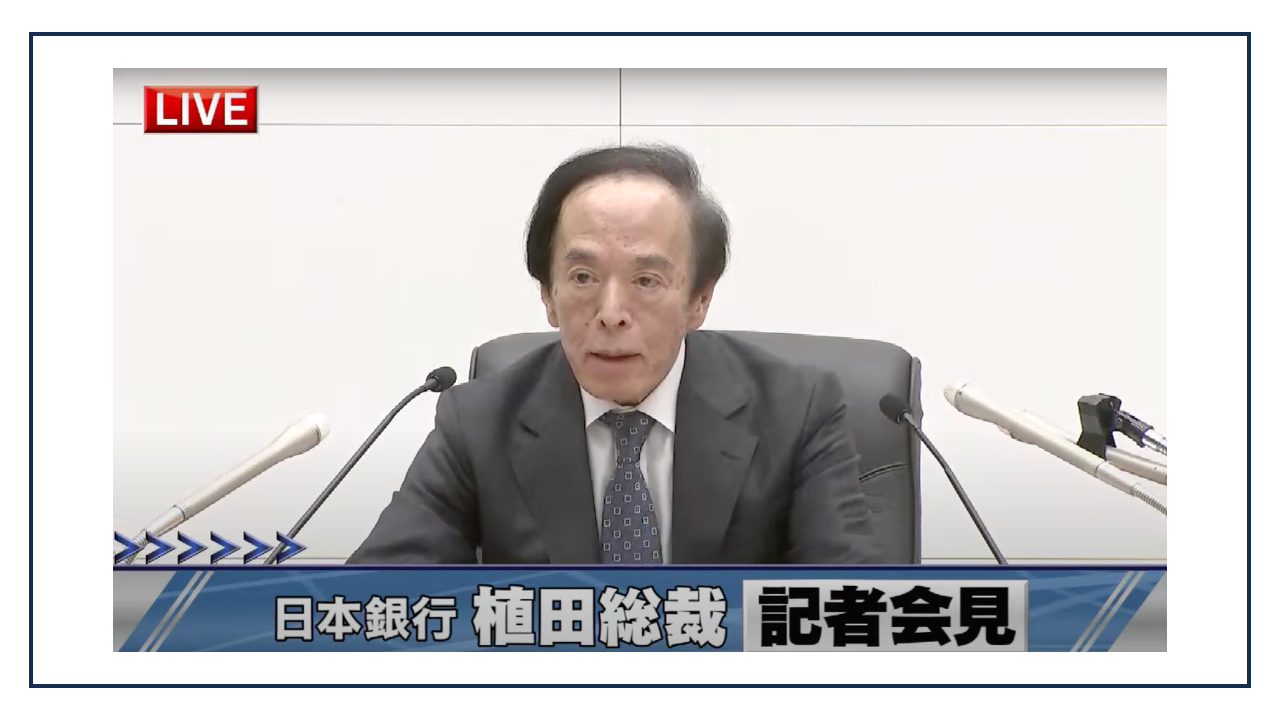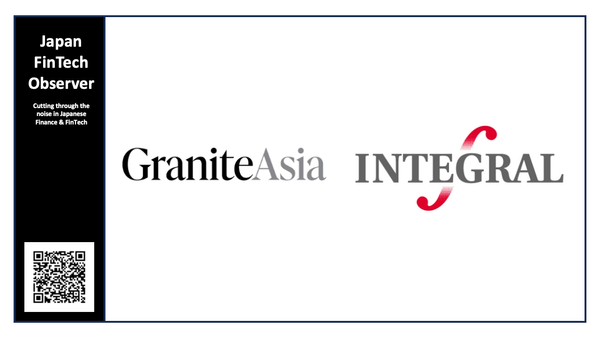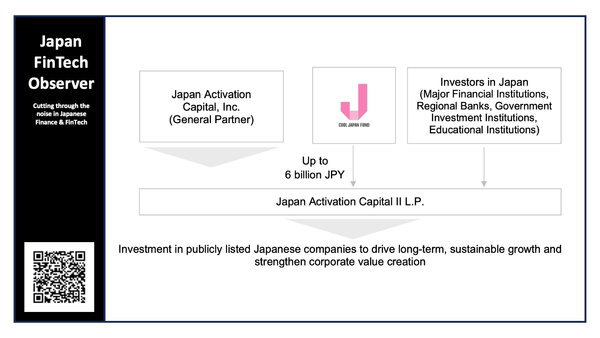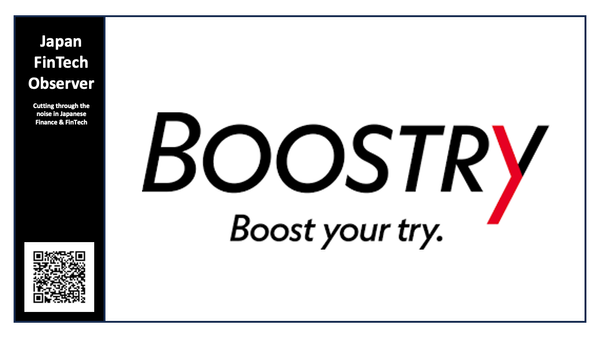The Bank of Japan's post-MPM press conference

We always like to listen to the Bank of Japan's press conference after the Monetary Policy Meeting, not so much for the prepared statements, which can be read independently, but for the Q&A session. So here is what we have learned.
I. Governor's Prepared Statement
The Governor began by outlining the key decisions made at the Monetary Policy Meeting:
- Policy Rate: The BOJ decided to maintain its current monetary policy, guiding the overnight call rate (a key short-term interest rate) to around 0.5% . This decision was made unanimously.
- Economic Assessment: The BOJ assessed that Japan's economy is "recovering moderately," although "some weakness" is observed in certain areas.
- Economic Outlook: The BOJ anticipates that the global economy will continue to grow moderately. With the support of accommodative financial conditions, a virtuous cycle of income and spending will gradually strengthen in Japan. This should lead to growth exceeding the country's potential growth rate.
- Price Developments: The year-on-year change in the Consumer Price Index (CPI), excluding fresh food, is currently in the "lower 3% range." While the impact of pass-through from higher import prices is waning, gradual increases in service prices due to rising wages are expected to continue. The government's energy subsidy reduction is also contributing to the current inflation level.
- Price Outlook: The BOJ projects that the underlying inflation rate will gradually increase, driven by a tightening labor market (due to labor shortages), improvement in the macroeconomic supply-demand gap, and a continued strengthening of the wage-price spiral. This is expected to contribute to a rise in medium- to long-term inflation expectations. The BOJ anticipates that inflation will be "generally consistent with the price stability target" towards the end of the projection period in the Outlook Report.
- Risks: The Governor emphasized that uncertainties surrounding the economic and price outlook remain high. Key risk factors include:
- Global trade policy developments and their impact on global economic and price trends.
- Trends in resource prices.
- Corporate wage and price-setting behavior.
- Developments in financial and foreign exchange markets and their potential impact on the Japanese economy and prices. The Governor noted that exchange rate fluctuations have a greater impact on prices compared to the past, given the recent trend of more proactive wage and price-setting behavior by companies.
- Future Monetary Policy: The Governor stated that the BOJ will continue to adjust the degree of monetary accommodation (i.e., raise policy interest rates) if the projected economic and price developments materialize, given that real interest rates are currently at "extremely low levels."
- Commitment to Price Stability: The BOJ remains committed to achieving its 2% price stability target in a sustainable and stable manner. Monetary policy will be conducted appropriately, taking into account economic, price, and financial conditions.
II. Questions and Answer Session
The Q&A session covered a wide range of topics, focusing on the BOJ's assessment of the economy, inflation, and future policy direction.
A. Wage Increases
- Question: How does the BOJ view the recent wage increases announced by major companies, especially after the March 12th "Shunto" (spring wage negotiations) settlement? How will these wage increases affect future monetary policy decisions?
- Governor's Response: The Governor acknowledged the significant wage increases resulting from the Shunto negotiations. He highlighted that the initial results from Rengo (Japanese Trade Union Confederation) showed a wage increase rate of 5.28%, which is slightly higher than the 3.8% of last year. He also noted that relatively smaller firms also saw higher wage increases, which shows that the trend is spreading. He assessed that these results are "generally in line" with the BOJ's expectations in the January meeting. The Governor cautioned that some smaller and medium-sized enterprises (SMEs) are still in the process of wage negotiations, and the BOJ will continue to monitor these developments closely. The Governor reiterated that monetary policy decisions will be based on a comprehensive assessment of economic, price, and financial conditions, not solely on wage trends. The BOJ will evaluate the impact of these factors on the economic and price outlook, as well as the risks to achieving the outlook.
B. Recent Price Developments
- Question: Recent data, such as the January CPI and February Corporate Goods Price Index (CGPI), show continued high growth. Are these developments within the scope of the BOJ's inflation outlook and baseline inflation assumptions outlined in the January Outlook Report?
- Governor's Response: The Governor acknowledged the recent high inflation figures, including the 3.2% year-on-year increase in the January CPI (excluding fresh food) and the roughly 4% increase in the CGPI. He recognized the negative impact of rising prices on household finances. He explained that the recent CPI increase is partly due to the reduction in government energy subsidies and rising rice prices. While rising food prices due to weather conditions are a temporary supply shock, they could indirectly influence underlying inflation by affecting household sentiment and inflation expectations. However, the Governor stated that, even considering these factors, the BOJ's assessment remains that underlying inflation is "gradually increasing but still below 2%." The BOJ will continue to carefully analyze various price indicators, as well as macroeconomic factors such as the supply-demand gap, inflation expectations, and wage increases, to assess the price situation.
C. Trade Policy and US Election
- Question: The BOJ statement mentions "trade policy developments" as a risk factor. Does this refer to the potential for tariffs from a future Trump administration? Given the potential for significant tariffs on steel, automobiles, and other goods, and the general uncertainty surrounding trade policy, will the BOJ be more cautious about raising interest rates? Also, 1 year ago today, the BOJ ended it's negative interest rate policy. How do you assess the effects of the monetary policy normalization?
- Governor's Response: The Governor acknowledged the rapid increase in the breadth and speed of potential US tariff policies. He stated that the BOJ will closely monitor trade policy developments, assess their impact on the US and global economies, and, subsequently, on the Japanese economy. The BOJ will then assess the impact on the country's economy and inflation forecast to determine monetary policy. The stance remains unchanged. For the 1 year anniversary, the governor states the policy, overall, has been slowly converging to the 2% target, as it should be, and the BOJ was able to adjust the level of policy accordingly.
D. Related to Balance Sheet
- Question: Could you elaborate on the BOJ’s balance sheet reduction plan, and specifically, the ETF disposition plan?
- Governor's Response: The reduction in government bond purchases has been proceeding as planned. An interim assessment will be conducted in June, including the extent of market functionality recovery. If needed, modifications to the current plan will be made. For ETF’s, the governor states that they need more time to come to a reasonable conclusion on how to dispose of them, and will continue to work on the solution.
E. Domestic vs. Overseas Risks and Underlying Inflation
- Question: Given the favorable domestic wage and price developments and the increasing uncertainties in the global economy, which type of risk does the BOJ currently give more weight to – domestic upward inflation risks or overseas downside risks? Has the upside risk to CPI, as indicated in the January Outlook Report, decreased? Also, what is the most accurate way to gauge the current Underlying Inflation Rate?
- Governor's Response: The Governor responded that the BOJ takes both the domestic and overseas factors into account when making future monetary policy decisions. He added that he believes there is a lot of uncertainty with the overseas factors, and it is difficult to put quantitative values on the uncertainty. As for the spring wage numbers, the governor believes that they are slightly stronger than what he would have expected. As such, the BOJ will take both aspects into consideration and decide the future monetary policy accordingly. In terms of the Underlying Inflation Rate, the Governor believes that it is important to make a more explicit way of calculating the Underlying Inflation Rate. However, no satisfying solutions have been found, and will continue to search for a valid way to calculate the rate. Currently, the Governor believes the rate to be around the 1-2% range.
F. Yen Manipulation and Difficulties in Rate Hikes
- Question: Mr. Trump criticized Japan's yen manipulation policy and mentioned that he would impose tariffs in case of intervention. How does the governor respond to that? Also, compared to January, is it more difficult to raise rates now?
- Governor's Response: The Governor states that he will not be commenting on the statement by Mr. Trump. He also added that the BOJ’s policy will depend on the economy and the inflation outlook. With that said, there are uncertainties about the global economy, but domestic wage conditions remain strong, which makes it imperative to consider both factors when making a decision.
G. Neutral Interest Rate
- Question: Could you elaborate on the neutral interest rate?
- Governor's Response: The Governor states that the estimates for the neutral interest rate still has not been narrowed. As such, the BOJ will monitor the economy closely to best determine the policy for the future. With that said, the nominal interest rate is equal to the neutral interest rate, plus inflation. Therefore, uncertainty remains with the view on potential growth rate. As for the Financial Institution Bureau, they will be attending, so that a determination can be made on how financial systems are responding to the interest rate increases. Secondly, this would allow the bureau members to have the most up to date information about monetary policy decisions.
H. Waiting for Certainty vs. Acting Proactively
- Question: With the uncertainties of the United States and the global economy, is it better to wait? Also, could you please elaborate on the specifics of downside risks when it comes to trade policy?
- Governor's Response: The Governor noted that there will always be a risk that you will be too late in reacting if you wait. One mechanism would be tariffs, which affects production and inflation directly. Secondly, confidence levels can go down because of tariffs, which would create a shock in the market.
I. Long-Term Interest Rate and Rising Food Prices
- Question: Could you explain the recent increase in the long-term interest rate, and do you believe this is due to returning to normal monetary policy? Secondly, do you think that food prices will have a negative effect on the monetary policy?
- Governor's Response: For the long-term interest rate, the government believes that the most recent increases are due to the recent economic data, in particular, inflation data and wage increase data, as well as the recent interest rate increase in Germany.
- Question: What effect does this rise of rice prices have on household prices? Also, it appears there is no way to directly impact the rising rice and produce prices with the current monetary policy. Can you elaborate?
- Governor's Response: The Governor added that this is considered a temporary supply shock. There may be some impact to expected inflation due to food prices. The BOJ cannot directly influence these prices, and if the need arose to lower food prices, the cost would be too great.
J. State of Japanese Economy
- Question: Private forecasts show negative to minimal growth in Q1 and sluggish capital expenditure numbers. Is the Japanese Economy really on track, and will you continue to raise rates even with that? Also, if long term interest rates go up, how will that impact policy making?
- Governor's Response: For the first quarter GDP, the data released by the BOJ is weak. However, there is a special factor relating to the Chinese New Year in January, which negatively skews the numbers. With that said, decisions will be made based on the inflation forecast. It would be unlikely that the interest rate is raised while the economy is bad.
- Question: If long term interest rates go up, how will that impact policy making?
- Governor's Response: He believes that the long term effect to economic activity is centered in the short to midterm zone. At the current state, it is still very negative, and thus supporting economic activity.
K. Cost of Rising Prices
- Question: People are cutting spending because goods are getting more expensive. With the rise of prices, what impact will that have on prices? Is there a risk of being too slow?
- Governor's Response: He believes the prices of everyday items may weaken a bit, but does not have a strong negative impact. However, the BOJ wants to support the 2% goal on a continuous basis. As such, there are worries about the inflation numbers, and there is no evidence that we are slow.
L. Market Unrest, Rate Hikes, and Regional Banks
- Question: Does market unrest prevent the government from rate hikes? Also, given that there are increasing reports of regional bank consolidation, what impact does raising interest rates have?
- Governor's Response: The Governor stated that the government did take note of the instability from August and September 2024, and this does not apply now. It’s a matter of degree. The BOJ cannot interfere with that decision.
M. Savings/Mindset, Potential Growth Rate, and Consumer Spending
- Question: Given current market conditions, consumer sentiment has been worsening for consecutive months. As such, the BOJ sees consumer spending as not going up or down. Is there a way to correlate this with the potential growth rate of 0.5%?
- Governor's Response: While that may be the average over a long time period, with real wages rising as expected, consumer spending has room to go up in the short and medium term.
Please follow us to read more about Finance & FinTech in Japan, like hundreds of readers do every day. We invite you to also register for our short weekly digest, the “Japan FinTech Observer”, on LinkedIn, or directly here on the platform.
We also provide a daily short-form Japan FinTech Observer news podcast, available via its Podcast Page. Our global Finance & FinTech Podcast, “eXponential Finance” is available through its own LinkedIn newsletter, or via its Podcast Page.
Should you live in Tokyo, or just pass through, please also join our meetup. In any case, our YouTube channel and LinkedIn page are there for you as well.




